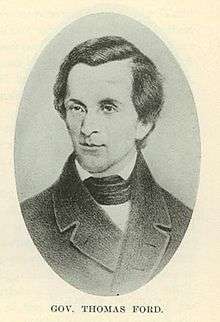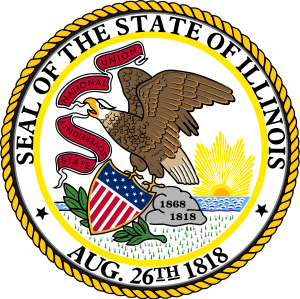Thomas Ford (politician)
| Thomas Ford | |
|---|---|
 | |
| 8th Governor of Illinois | |
|
In office December 8, 1842 – December 9, 1846 | |
| Lieutenant | Stinson Anderson |
| Preceded by | Thomas Carlin |
| Succeeded by | Augustus C. French |
| Personal details | |
| Born |
December 5, 1800 Uniontown, Pennsylvania |
| Died |
November 3, 1850 (aged 49) Peoria, Illinois |
| Political party | Democratic |
| Spouse(s) | Frances Hambaugh |
| Profession | Law |
Thomas Ford (December 5, 1800 – November 3, 1850) was the eighth Governor of Illinois, and served in this capacity from 1842 to 1846. A Democrat, he is remembered largely for his involvement in the death of Joseph Smith, and the subsequent Illinois Mormon War. He is also the author of A History of Illinois (Chicago, 1854), published posthumously about the state from its founding in 1818 until 1847.
Life
Ford was born in Uniontown, Fayette County, Pennsylvania. He was the first governor to grow up in Illinois. His widowed mother took him and his siblings west in hopes of crossing the Mississippi River in 1804 to buy cheap land. At St. Louis she was told about the Louisiana Purchase and that land was no longer cheap there because it now belonged to America. So she settled in Illinois instead.
Ford was the half-brother to George Forquer, who later became the state's attorney general. The two would eventually share a law office together, and Forquer aided Ford in his early years as a lawyer and judge, but he took a brief time away from the law to become a spy against Black Hawk shortly before the Black Hawk War in 1832. He was the state's attorney in Western Illinois, then was elected as a state court judge in the north in 1836. He later served as a municipal judge in Chicago, before becoming a state court judge again. This led to his joining the Supreme Court of Illinois as an associate justice, 1841–42. He was very interested in politics and bragged that he attended every session of the state legislature from 1825–1847.
Ford married Frances Hambaugh in 1828 and had five children by her, but his personal life was never calm. He was accused of taking "stimulants" as governor, suggesting that it might have harmed his career, but there is no definitive evidence of drug abuse. His wife died of cancer in 1850 at the age of 38, and he followed her in death three weeks later from tuberculosis in Peoria, Peoria County, Illinois. Interment was at Springdale Cemetery, Peoria. Ford County, Illinois is named for him.[1]
The couple had three daughters, two of which were said to have died young. Ford's two sons were both lynched as outlaws in Kansas in the 1870s, one dying under mysterious circumstances.
Governorship
Ford's rise in the judiciary led to his election as governor in 1842, becoming one of the most controversial politicians in the nation's history. He worked hard to repair the fiscally irresponsible Internal Improvements Act that built expensive bridges, canals, roads and highways, often in places where few people or communities existed. This bill was passed years earlier with the aid of a previous state representative, Abraham Lincoln, and Ford's actions helped turn the economic crisis around, although the debt for the Act would not be paid off until 1882. Ford also worked to build the Illinois and Michigan Canal, which greatly improved the state's finances.
Illinois Mormon Expulsion
His tenure as governor is best remembered for the "Illinois Mormon Expulsion,"[2] particularly his dealings with the Mormon city of Nauvoo, Hancock County, Illinois, and with the death of their leader, Joseph Smith in 1844.[3]
Ford wrote extensively of his dealings with the Mormon community, and was especially critical of their religion. He called Smith "the most successful impostor in modern times," and said he hoped that the increasingly popular Mormonism would not replace traditional Christianity, which in turn would make him out to be a modern-day Pontius Pilate. Ford took some steps to impede the anti-Mormons, but with little results. The conflict grew heated, with hundreds being driven from their homes, and mobs that eventually employed several thousands of people.
At one point, Ford encouraged Joseph and his brother, Hyrum Smith, to go to Carthage, the county seat, to face criminal charges in the destruction of the newspaper, the Nauvoo Expositor. Once there, the Smiths were charged with treason, and Ford abandoned them to be guarded by the Carthage Greys, an anti-Mormon militia that helped murder them on June 27, 1844.
Ford denied being responsible. However, two men later gave affidavits suggesting Ford knew of the plot and could have approved of it. Dan Jones, a riverboat captain and one of the few eyewitnesses to both sides of the event, repeatedly warned Ford throughout the day of comments he heard from the guards and jailkeepers concerning their plot to assassinate the Mormon leaders. In response, Ford replied, "You are unnecessarily alarmed for your friends safety sir. The people are not that cruel." Irritated by the remark, Jones urged the necessity of placing better men than professed assassins to guard them. He stressed that they [the Smiths] were American citizens surrendered to his [Ford's] pledged honour. When Ford showed little interest in Jones' concerns, Jones commented "[I] had then but one request to make; if you [Ford] left their lives in the hands of those men to be sacrificed, that the Almighty will preserve my life to a proper time and place to testify that you have been timely warned of their danger." Later that day, returning to Nauvoo on horseback, Jones passed Ford's company while it passed by a painted mob ready to enter Carthage to kill the Mormon leaders. Jones records that while the assassination was taking place in Carthage, Ford addressed the citizens of Nauvoo saying that a "severe atonement must be made so prepare your minds for the emergency." The officials of the governor were heard urging him to hasten from there assuring him that the deed (that is the assassination) "was sure of having been accomplished by then." Both Ford's statement and the comments of his supporting officials provide strong evidence of Ford's involvement. He was later claimed to have said, "it's all nonsense; you will have to drive the Mormons out yet." This is exactly what happened. Several residents of Hancock County, and many residents from several surrounding counties, met and decided on a plan of action that later forced the Mormon retreat into Utah, led by Brigham Young, by 1846.
While Ford opposed the Mormons, he also claimed to oppose the anti-Mormon faction that eventually drove them from the state. Ford defended his meek actions during the crisis, saying hated minorities are never safe from hostile majorities. He said, "Men engaged in unpopular projects expect more protection from the laws than the laws are able to furnish in the face of popular excitement." He believed that a politicized militia and court system, as well as weak powers granted him by state law, prevented him from doing more to stop the Illinois Mormon War. Writing in the third person, Ford declared "there was no way to punish {the guilty parties}, as former trials had shown, except by martial law; and this course was utterly illegal. The governor believed that he could not declare martial law for the punishment of citizens without admitting that free government had failed; and assuming despotism was necessary in its place."[4] His criticisms lead to a constitutional convention in 1847, which empowered future governors over state affairs.
Notes
- ↑ Gannett, Henry (1905). The Origin of Certain Place Names in the United States. Govt. Print. Off. p. 128.
- ↑ Roberts, Brigham H. (1900). The Rise and Fall of Nauvoo. Salt Lake City: The Deseret News. pp. 292–300.
- ↑ http://www.boap.org/LDS/Early-Saints/WAdams.html
- ↑ Ford, Gov. Thomas (1946). A History of Illinois from its commencement as a State in 1818 to 1847, Vol. II. Chicago: The Lakeside Press/R.R. Donnelly & Sons Co. p. 340.
References
- This article incorporates facts obtained from: Lawrence Kestenbaum, The Political Graveyard
- Jones, Dan, "The Martyrdom of Joseph Smith and His Brother Hyrum" BYU Studies. See
- Ford, Thomas (1854), A History of Illinois, from its Commencement as a State in 1818 to 1847, Chicago: S.C. Griggs & Co..
- Ford, Thomas, A History of Illinois (1995 edition with introduction by Rodney O. Davis. Urbana and Chicago: University of Illinois Press. 1995).
External links
- Illinois 2005–2006 Blue Book
- John Cushman Abbott Exhibit Supplement—includes a discussion of Ford and his book A History of Illinois, from its Commencement as a State in 1818 to 1847, and a downloadable pdf of the book.
| Political offices | ||
|---|---|---|
| Preceded by Thomas Carlin |
Governor of Illinois 1842–1846 |
Succeeded by Augustus C. French |
